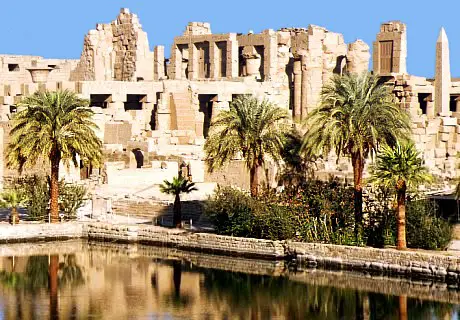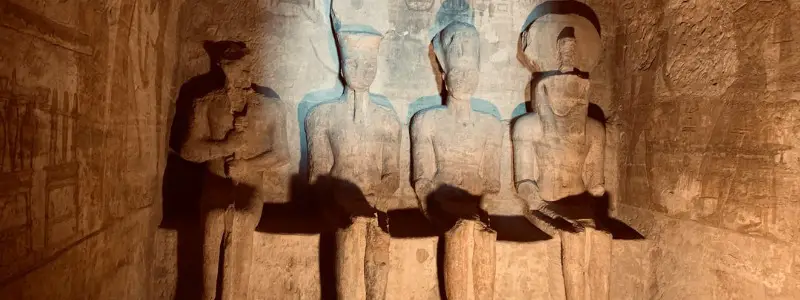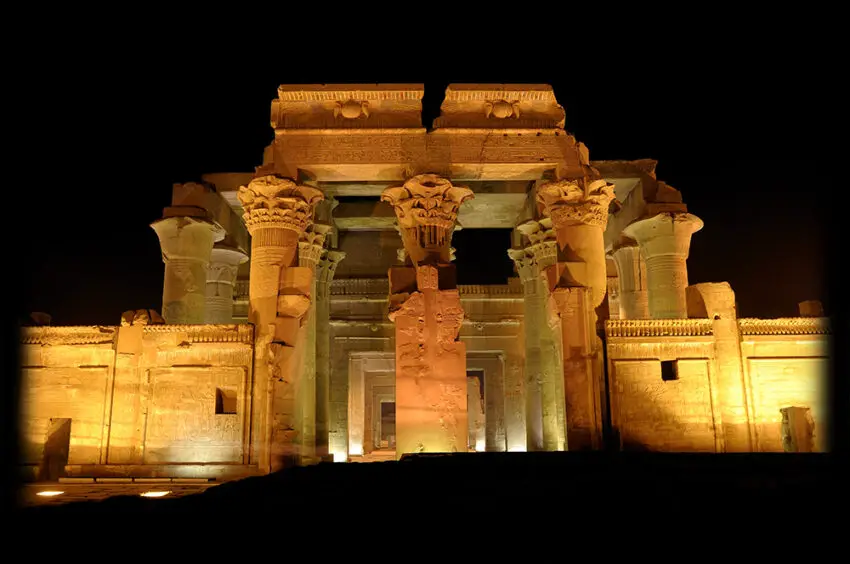Karnak Temple Facts
Table of Contents
Karnak is a Temple complex in Egypt that consists of several buildings, among which are the 4 main temples. These temples contain important pieces of history that are still standing tall today. Here we have the Temple to the goddess Mut to the south, The Temple of Aten on the north, the Temple to the god Montu, and a large Temple to the god Amun in the center. Karnak literally translates to “the most selected of places”. And – it truly is.
The Temple of Amun
The Temple of Amun is a complex on its own, which consists of numerous separate buildings that form a huge religious site in the center of Karnak. Huge wall made from the mud bricks represented a border between the sacred grounds and commoners. Many parts of the Amun-Ra’s Temple are open only the priests. This just shows how important the clergy was in the culture of that time.

Construction of Karnak
The construction of Karnak Temple complex was lengthy, as every type of construction was at the time. That’s quite logical since the sandstone used for the building of Karnak had to be brought from more than 100 miles away. It came from the quarries located on the River Nile. The construction was so slow that it usually took several rulers to complete the building. Most of the time, one king would begin the construction, and his kin would finish it centuries later. Each ruler would add on to the work of his predecessor.
FUN FACT: Did you know that pharaohs were capable of erasing history?
Or something like that. The halls of Karnak Temple complex have witnessed many stories of pharaohs’ rise and falls. The mad queen’s story is quite interesting. Namely, the Queen Hatshepsut was a regent for her late husband’s child. The child wasn’t hers; it was from another wife of Thutmose II. When he died, she was acting as a regent for the boy in the next 7 years, but then she proclaimed herself as a male pharaoh. She even gave herself a royal mark.

During the course of her reign, she built a lot of edifices at Karnak. She added two obelisks, raised new monoliths, remodeled the temple of Senusret, added more rooms and did so much more. However, it was all in vain. When she died, The Pharaoh Thutmose III resumed the throne, and once he did, he tore down some of the Hatshepsut’s constructions, defaced the others entirely, and covered up most of her work. This also included the erasing of the queen from whatever relief that was painted and chiseled. It was as if she never existed in the Karnak’s history.
The Witness of Egyptian History
Why is Karnak Temple complex so important? Well for starters, it’s several thousand years old. Even today, historians used the inscriptions on the walls so that they could reconstruct the Egyptian history. This is where many important moments were conceived, the moments that would change the history of Egypt forever. In the 17th century, Karnak Temple complex became one of the most important religious sites in the entire Egypt. Religion was closely woven with politics. Karnak’s significance rose as the temple began to be used for the king coronation rituals. It’s always good to be a king, but at that time, it literally meant that you are a god as well.
Karnak Kom Ombo Temple
Also, here are some more interesting facts about the Karnak sites. The Kom Ombo Temple at Karnak is probably the first place in the world where surgical instruments were invented – explorers found forceps, scalpels, birthing chairs and medicine bottles that go all the way back to Roman times.
While we are talking about medicine, you should know that there is a thing called the Temple Fatigue. It’s very real and symptoms can be you not remembering the sights you visited, or the order you visited them or even what was the time and day of your visit! But worry not, except mild disorientation, it’s nothing horrible and health-threatening. Just make sure to take a lot of photos!

FUN FACT: Pharaohs used photoshopping techniques?
The tradition of photoshopping one’s image into something better is obviously a couple of thousands of years old habit. Pharaohs were always depicted as athletically built, with bodies idealized to perfection but in reality that usually wasn’t the case. Talk about a false profile (hieroglyph) picture, right?
Egypt’s Favorite Tourist Destination
What about Karnak Temple complex today? Together with Luxor, these sites are one of the most visited sights in the entire world, right after the pyramids of Giza. The only section that is open to the public is the Amun’s Temple. The other areas are being reconstructed or are currently explored. You can enter the temple through the Sacred Way (the Avenue of Sphynxes), that used to stretch between Luxor and Karnak.
Karnak in Numbers
Hypostyle Hall has 134 pillars that are up to 70 feet tall. Only the hall covers around 65,000 square feet alone! Basically, the Hypostyle Hall can comfortably fit the entire Notre Dame Cathedral.
More than 30 pharaohs in succession added to the temple.
The construction of Karnak began in the 16th century BC.
It is thought that more Karnak was in construction for more than 1300 years. Talk about a long remodeling!
The only remaining obelisk weighs more than 323 tons.
More than 420,000 animals were held at Karnak temple grounds since they were considered sacred to Amon. Regular people weren’t even allowed inside.
80,000 slaves and servants served Amon-Ra. How were they allowed on the sacred grounds? Well, they weren’t considered to be people. How rude! Of course, still only nobility and priests had access to the most sacred temples.

